WHAT'S NEW ACROSS THE WORLD
What's
new April 2000
What's
new July 2000
| What's New ©by
Laif DeMason
Hey, what’s this? Sales of cichlids in the United
States have nearly doubled since the last installment of “What’s New”,
indicating the beginning of a strong cichlid season! While domestic fuel
prices may make us grumble, in more remote areas of the world, the energy
crisis is even more serious. Severe price increases and fuel shortages
are plaguing aquarium fish collectors and exporters. Not only are basic
costs of getting to collecting areas and to airports with shipments on
a rapid rise, but the cost of air freight cargo has also jumped due to
the expense of jet fuel! Scaling back to conserve money and fuel is the
order of the day. In spite of all this, supplies of imported cichlids are
still good for the moment!
Here’s “what’s new” on the cichlid scene: |
Lake Tanganyika
Bred fishes are in good supply, and import items are available in fair
numbers as well. Some of the recent shortages from Zambia have been
reversed, but central Tanzania is still problematic. There are still
no collections from the Congo (Zaire) shores.
|
what's new: Lake Tanganyika
|

Exported from Zambia, this colorful, bright-orange
form of Neolamprologus mustax arrives sporadically. |
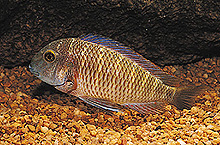
Reportedly from the southern shores of Tanzania, another
rainbow form of Tropheus moorii is distinguished by its bluish fins. |

Originally from Ubwari (Congo), Tropheus sp.
“green” often develops red flecks on the body as it ages. |
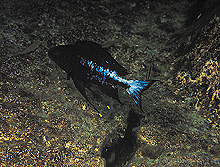
Infrequently collected, but usually available from
speciality breeders, Ophthalmotilapia boops “neon Kipili” is a choice
featherfin. |
Lake Malawi
Collection efforts have temporarily bogged down in Lake Malawi, but
stocks are especially strong from fish farms, limiting export demand.
Exports from both Malawi and Tanzania have slowed due to bottlenecks with
carriers; also, fewer collectors are now working in the lake.
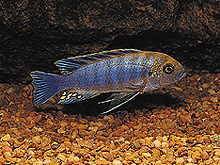
Reportedly from the eastern shore of Malawi, Cynotilapia
afra “edwardi-type” first arrived earlier this year. |
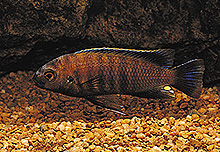
Newly exported from the northeastern lakeshore in
Tanzania, this “broadmouth” mbuna is related to Pseudotropheus novemfasciatus
from southwestern sections of the lake. |
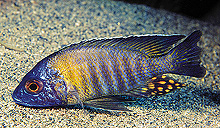
From Magunga (Tanzania), Aulonocara gertrudae
has been an available export of late. Photo by A. Konings. |

Though infrequently exported, Nimbochromis livingstonii
has
recently arrived from Manda (Tanzania) sporting an ivory ground coloration. |
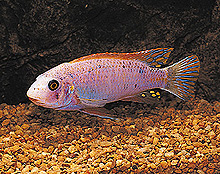
Developed in Florida, Labeotropheus trewavasae
“Opal” has whitish-orange males with an opalescent cast and classic orange-colored
females. |

Having caused a stir in the mid-80s, Aulonocara
saulosi, or the metallic green-face peacock, is now making a comeback
with both hobbyists and breeders. |
Victoria
Unfortunately, new collections and exports from the Victorian basin
have stalled, with no immediate resolution apparent. Hobbyists are
still relying on bred material from various sources. An occasional
novelty arises!
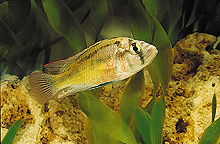
One of the few “limax” varieties bred here and there
from years ago, this haplochromine is yellowish with a reddish chest. |
 Variably sold as Haplochromis obliquidens or H. “thick-skin,” the
so-called “red-tail” and “blue” morphs are essentially the same fish.
Variably sold as Haplochromis obliquidens or H. “thick-skin,” the
so-called “red-tail” and “blue” morphs are essentially the same fish. |
West Africa
Exports from the usual places, such as Nigeria and Congo, remain unabated,
while items from Cameroon and Guinea are currently best obtained from speciality
breeders.

Exported from Nigeria and occasionally elsewhere,
this Hemichromis fasciatus female is set up for breeding with an
aggresive mate. Photo by J. Rapps. |
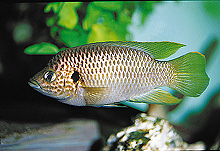 First appearing in France some time ago, Hemichromis sp. “Simballa”
has been received from Guinea. Photo by O. Lucanus.
First appearing in France some time ago, Hemichromis sp. “Simballa”
has been received from Guinea. Photo by O. Lucanus. |
Neotropics
Exports from many areas of South America are strong. Wild
discus (Symphysodon), unusual Apistogramma, and geophagines always seem
to be popular. Other large guapotes can be procured from specialized
breeders.
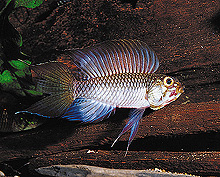
Always an attractive novelty, this new Apistogramma
reportedly hails from the Rio Uaupes in western Brazil. Photo by
O. Lucanus. |
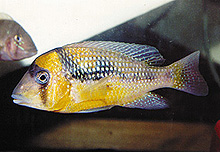
Originally from Uruguay, Gymnogeophagus gymnogenys
“Rosario” is an interesting color variety. Photo by J. Rapps. |
|











 Variably sold as Haplochromis obliquidens or H. “thick-skin,” the
so-called “red-tail” and “blue” morphs are essentially the same fish.
Variably sold as Haplochromis obliquidens or H. “thick-skin,” the
so-called “red-tail” and “blue” morphs are essentially the same fish.
 First appearing in France some time ago, Hemichromis sp. “Simballa”
has been received from Guinea. Photo by O. Lucanus.
First appearing in France some time ago, Hemichromis sp. “Simballa”
has been received from Guinea. Photo by O. Lucanus.
